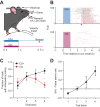Temporal correlations among functionally specialized striatal neural ensembles in reward-conditioned mice
- PMID: 26763779
- PMCID: PMC4808099
- DOI: 10.1152/jn.01037.2015
Temporal correlations among functionally specialized striatal neural ensembles in reward-conditioned mice
Abstract
As the major input to the basal ganglia, the striatum is innervated by a wide range of other areas. Overlapping input from these regions is speculated to influence temporal correlations among striatal ensembles. However, the network dynamics among behaviorally related neural populations in the striatum has not been extensively studied. We used large-scale neural recordings to monitor activity from striatal ensembles in mice undergoing Pavlovian reward conditioning. A subpopulation of putative medium spiny projection neurons (MSNs) was found to discriminate between cues that predicted the delivery of a reward and cues that predicted no specific outcome. These cells were preferentially located in lateral subregions of the striatum. Discriminating MSNs were more spontaneously active and more correlated than their nondiscriminating counterparts. Furthermore, discriminating fast spiking interneurons (FSIs) represented a highly prevalent group in the recordings, which formed a strongly correlated network with discriminating MSNs. Spike time cross-correlation analysis showed the existence of synchronized activity among FSIs and feedforward inhibitory modulation of MSN spiking by FSIs. These findings suggest that populations of functionally specialized (cue-discriminating) striatal neurons have distinct network dynamics that sets them apart from nondiscriminating cells, potentially to facilitate accurate behavioral responding during associative reward learning.
Keywords: associative learning; correlations; single-unit recordings; striatum.
Figures








References
-
- Alexander GE, DeLong MR, Strick PL. Parallel organization of functionally segregated circuits linking basal ganglia and cortex. Annu Rev Neurosci 9: 357–381, 1986. - PubMed
-
- Arieli A, Sterkin A, Grinvald A, Aertsen A. Dynamics of ongoing activity: explanation of the large variability in evoked cortical responses. Science 273: 1868–1871, 1996. - PubMed
-
- Averbeck BB, Latham PE, Pouget A. Neural correlations, population coding and computation. Nat Rev Neurosci 7: 358–366, 2006. - PubMed
Publication types
MeSH terms
Grants and funding
LinkOut - more resources
Full Text Sources
Other Literature Sources
Research Materials
Miscellaneous

